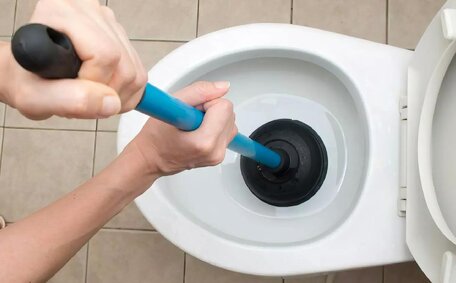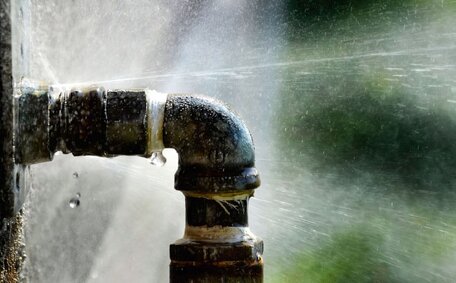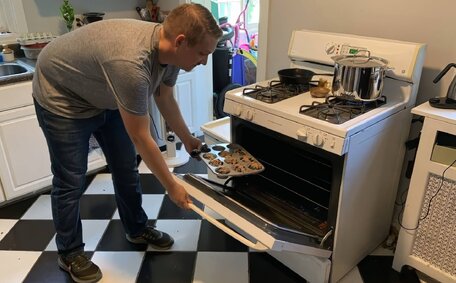Identifying a Blocked Shower Drain
There are a few key signs that indicate drain blockages in your shower:
- Standing water pools around your feet when showering instead of draining properly
- The water drains very slowly, can take longer than usual to empty
- You hear gurgling sounds indicating a potential drain clog
- Unpleasant odours come from the drain
To fix clogged drain in the shower, it’s often due to an accumulation of long hair, dead skin, soap scum, and other debris. Over time, the grime builds up and blocks the pipes, preventing proper water flow. Catching a clogged drain early is key Before the drain can cause backups elsewhere in your plumbing system.
Start by removing the drain cover and use your hands or a wire coat hanger to gently unclog drain, removing hair clogs or debris around the drain opening. If you can visibly see a considerable mass stuck in there, this is likely your clog. Continue on, as we offer several effective strategies to clear out any stubborn blockage.
Using a Plunger to Unclog
A plunger is highly suitable to unblock your shower drain with a stubborn blockage. Here’s how you can unblock shower effectively:
- Fill the base with a few inches of water - this assists in forming a seal when using plunger.
- Place the plunger firmly over the drain opening.
- Vigorously plunge up and down 10-15 times, creating suction to propel the clog out into the drain.
- Give a final hard push down and lift/twist the plunger to break the seal.
- Remove the plunger and see if water drain effectively once it starts clearing. You may need to run some tests and repeat the process a few times.
Make sure to wear rubber gloves during the process to protect your hand as you learn how to unclog your shower using manual methods. It’s also wise to lay towels around the tub edge to contain any splashing or overflow.
Focus on addressing how unclog your clogged drain by securing a tight seal between the plunger cup and the drain as you work. Applying quick, vigorous motions is key to generating enough suction power to successfully unclog your shower. Start gently and increase your speed and pressure, and If trouble persists, get in touch with us for professional assistance.
A sturdy drain plunger also provides which can provide easy steps to aid when dealing with your sink, effectively conforming to its drain similar to tub drains with its cupped end. With the proper technique, it can clear shallow obstructions like hair & soap scum clogs.
Trying Baking Soda and Vinegar
Employing the combination of vinegar baking constituents is an effective, non-toxic home remedy to tackle a blocked shower drain. Here’s how to use baking soda vinegar to tackle the issue:
- Remove the drain cover and ensure there is nothing visibly blocking the drain opening
- Pour 1 cup of baking soda down the drain directly into your blocked drain
- Begin with 1 cup baking soda followed by cup white vinegar to witness the fizzing reaction that takes place
- Place the stopper or a towel over drain to contain the soda and vinegar reaction
- Let it sit for 5-10 minutes so the mixture can work to break up the clog
- Boil a pot of water and carefully pour down the boiling water into the drain to rinse away any lingering buildup
- Run hot water through the shower drain for a minute to flush it out further
This simple duo works wonders to clear clogged pipes and restore flow when baking soda and white vinegar combine, dissolving soap scum, hair, and grime with gentle fizzing and bubbling action. The granularity of baking soda white combines with the vinegar, providing a homemade way to clear clogged shower effectively.
Since both ingredients are natural products often used for cooking and cleaning, they offer a safe method free of harsh chemicals. However, take care when pouring the vinegar as it can bubble up quickly.
Check if you have managed to unclog shower drain properly after completing the treatment. You may need to repeat the process a couple times for stubborn clogs. Get in touch with us at Brighton-Le-Sands Plumbing if it fails to unclog the blockage.
Manually Removing the Clog
Before reaching for chemical drain cleaners, try manually removing the clog from your shower drain first. This involves what you can do: carefully extracting any visible hair or debris within your grasp to clear the blockage.
- Start by taking safety precautions like wearing thick rubber gloves and goggles.
- Remove the drain cover and use needle-nose pliers or tweezers to gently pull out any hair, soap scum, or gunk that is accessible.
- You can also try straightening out a wire coat hanger and fashioning a small hook on one end to fish out debris from deeper in the drain.
- Methodically twist and manoeuvre the hooked wire down the drain to engage the clog, then gingerly pull it out your way.
- Place any removed items into a trash bag and dispose properly.
- Proceed to pour hot water to flush drain shower and assess if your efforts fully resolved the clog.
Take care not to damage your bath when attempting to fix blocked shower. In such scenarios, we would suggest seeking a professional plumber’s help if you can’t clear the blockage yourself.
You can try using this method multiple times or combine it with a plunger for those tenacious obstructions and might find success. Pondering 'How do I know my shower is really clear?' after manually removing drain clogs avoids the use of corrosive chemical cleaners.
Using a Drain Snake/Wire to Dislodge
Pondering 'i know my shower is really clear?' If clogs persist deeper down, yyou can employ tools like a plumber’s snake or a reshaped coat hanger - they can perform marvels in loosening up the blockage.
- Straighten out the end of a metal wire coat hanger and bend a small hook on one end.
- Remove the drain cover plate and carefully insert the hooked end down into the drain, twisting gently.
- Slowly work the hooked wire down the down pipe further into the pipes, latching onto hair other types of debris when you feel resistance.
- Once you’ve snagged the blockage, gently twist and coax it upwards, ensuring you reach further down into the conduit.
- Run hot water for a few minutes afterwards to flush residue.
- You’ll discover you might need to repeat this process a few times to clear stubborn obstructions.
You can use a plumbing snake that works the same way but features a long, flexible metal coil you rotate while pushing down to catch and remove clogs. This technique, i know my way around, can be mastered with some finesse, so be delicate with these tools to avoid harming your pipes.
The key is to loosen the clog little by little each pass, rather than trying to pull up the entire mass at once. Learn how fix your drain issue with professional assistance if you’re unable to remove the blockage on your own using this method.
Avoiding Harsh Chemical Drain Cleaners
Harsh chemical drain cleaners may seem like an easy solution, but they should only be used as an absolute last resort to fix clogged shower drain.
These potent formulas, laden with ingredients like lye, sulfuric acid, or trichloroethane, can wreak havoc on pipes and fixtures, which raises i know my options for fixing plumbing more safely.
Your bathroom may benefit more from safer methods such as using a plunger, deploying baking soda and pour boiling water method, pouring boiling water, or employing the simple soda vinegar remedy. If those attempts to fix blocked drains fail, look for drain cleaner products that contain naturally-derived enzymes or bacteria instead of corrosive chemicals.
Should you opt for a commercial drain cleaner, find out how to protect yourself with safety gear such as gloves and goggles. Only use them in well-ventilated areas and never mix products containing acids and bases. Properly store leftovers out of reach of children and pets and dispose of any remaining product at your local household hazardous waste facility.
Repeated use of chemical drain cleaners can wear down your sewer pipes, leading to more frequent issues with your main sewer. Investigate the source of chronic blockages and In preparation for lease cleaning, consider professional drain cleaning services that use high-pressure water jets or snaking tools to remove obstructions while protecting the integrity of your plumbing.
Preventing Future Clogs
Preventing future shower drain clogs begins with establishing robust maintenance routines for your drains. Here are some tips:
- Install a drain cover or strainer to Catch what passes through your shower drains can help minimize clogs
- Wipe down your shower walls and floor after each use to ensure efficient drainage and that nothing unwanted is going down without blockage by soap scum or grime
- Regularly disposing a kettle of boiling water down shower drains can help prevent more serious issues with buildup, ensuring seamless water down drain
- Clean drain routine involves using a drain cleaner product monthly to disperse grime and maintain clear pipes
- Avoid letting hair accumulate by cleaning out the drain manually every few weeks
- Be mindful of use; toilet paper and human waste should be the only things to go down the drain - oil, grease, and thick hair products can stick to pipes
Taking just a few minutes for regular drain care and staying aware of what washes down your shower can prevent annoying and difficult clogs. Establishing these habits keeps drains clear, eliminates odours, and prevents more costly plumbing issues in the long run.
If you stay diligent with maintenance yet face persistent blockages as you approach end lease, consider it could signal a deeper problem. Have a professional inspect your pipes - older plumbing may need repairs or replacements to prevent obstructions.
Investing in proactive maintenance can help prevent time-consuming clog removal and is exactly what to do when ensuring your shower functions seamlessly for years to come, particularly crucial for end lease cleaning.
When to Call a Professional Plumber
As a homeowner, there comes a point when a blocked shower drain is beyond DIY methods and requires calling in a professional plumber. Here are some signs it’s time to pick up the phone:
- You’ve tried several home remedies like a plunger, baking soda/vinegar, boiling water, or manually removing the clog but the blockage persists.
- Water drains very slowly or the clog keeps recurring days or weeks after fixing it yourself.
- You can see or access the clog but it’s too large or deep to remove by hand.
- There is a foul sewage odour coming from the drain.
- The pipes make gurgling noises indicating sewage backup.
- Sinks or bathtubs also start draining slowly, signalling a larger line blockage.
A professional plumber like Brighton-Le-Sands Plumbing has specialised equipment to Clear even the most stubborn blocked drains you can’t tackle on your own at home. This includes:
- High-powered drain augers/snakes that reach deep into pipes to catch debris
- High-pressure water jetting to scour blockages
- Sophisticated camera inspection to pinpoint problems
- Specialty tools to extract hair, grime, and hard water mineral buildup
Our services include capabilities to remove drain clogging concerns across your home in Brighton-Le-Sands, Sunshine Coast, and the broader Sydney region.
If you have a blocked shower drain that basic approaches can’t fix, call Brighton-Le-Sands Plumbing at 1300 349 338 or email [email protected]. If you have a blocked shower drain that basic approaches can’t fix, call Brighton-Le-Sands Plumbing at 1300 349 338 or email [email protected].






